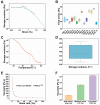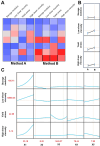Refining the rheological characteristics of high drug loading ointment via SDS and machine learning
- PMID: 38723048
- PMCID: PMC11081290
- DOI: 10.1371/journal.pone.0303199
Refining the rheological characteristics of high drug loading ointment via SDS and machine learning
Abstract
This paper presents an optimized preparation process for external ointment using the Definitive Screening Design (DSD) method. The ointment is a Traditional Chinese Medicine (TCM) formula developed by Professor WYH, a renowned TCM practitioner in Jiangsu Province, China, known for its proven clinical efficacy. In this study, a stepwise regression model was employed to analyze the relationship between key process factors (such as mixing speed and time) and rheological parameters. Machine learning techniques, including Monte Carlo simulation, decision tree analysis, and Gaussian process, were used for parameter optimization. Through rigorous experimentation and verification, we have successfully identified the optimal preparation process for WYH ointment. The optimized parameters included drug ratio of 24.5%, mixing time of 8 min, mixing speed of 1175 rpm, petroleum dosage of 79 g, liquid paraffin dosage of 6.7 g. The final ointment formulation was prepared using method B. This research not only contributes to the optimization of the WYH ointment preparation process but also provides valuable insights and practical guidance for designing the preparation processes of other TCM ointments. This advanced DSD method enhances the screening approach for identifying the best preparation process, thereby improving the scientific rigor and quality of TCM ointment preparation processes.
Copyright: © 2024 Qian et al. This is an open access article distributed under the terms of the Creative Commons Attribution License, which permits unrestricted use, distribution, and reproduction in any medium, provided the original author and source are credited.
Conflict of interest statement
The authors have declared that no competing interests exist.
Figures







Similar articles
-
Development of an Ointment Formulation Using Hot-Melt Extrusion Technology.AAPS PharmSciTech. 2016 Feb;17(1):158-66. doi: 10.1208/s12249-015-0453-3. Epub 2015 Dec 1. AAPS PharmSciTech. 2016. PMID: 26628438 Free PMC article.
-
Formulation characteristics and in vitro release testing of cyclosporine ophthalmic ointments.Int J Pharm. 2018 Jun 10;544(1):254-264. doi: 10.1016/j.ijpharm.2018.04.042. Epub 2018 Apr 21. Int J Pharm. 2018. PMID: 29684560
-
The influence of cetomacrogol ointment processing on structure: A definitive screening design.Eur J Pharm Sci. 2017 Mar 1;99:279-284. doi: 10.1016/j.ejps.2016.12.029. Epub 2016 Dec 29. Eur J Pharm Sci. 2017. PMID: 28042102
-
Clinical Strategy for Optimal Traditional Chinese Medicine (TCM) Herbal Dose Selection in Disease Therapeutics: Expert Consensus on Classic TCM Herbal Formula Dose Conversion.Am J Chin Med. 2015;43(8):1515-24. doi: 10.1142/S0192415X1550086X. Epub 2015 Nov 30. Am J Chin Med. 2015. PMID: 26621440 Review.
-
Perspectives on Physicochemical and In Vitro Profiling of Ophthalmic Ointments.Pharm Res. 2018 Oct 15;35(12):234. doi: 10.1007/s11095-018-2513-3. Pharm Res. 2018. PMID: 30324424 Free PMC article. Review.
References
Publication types
MeSH terms
Substances
LinkOut - more resources
Full Text Sources

